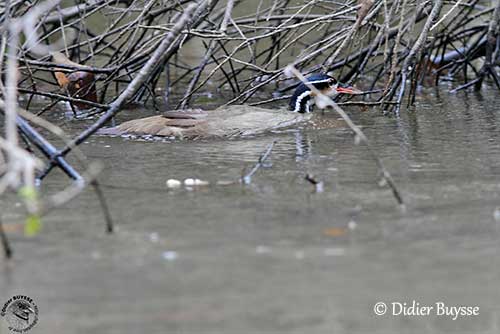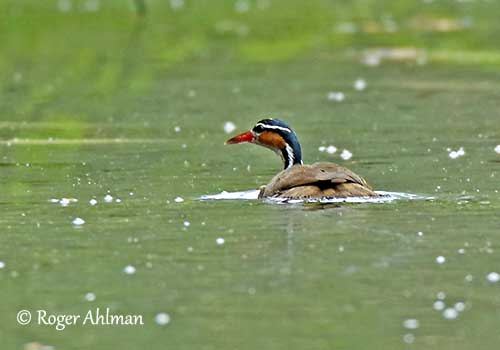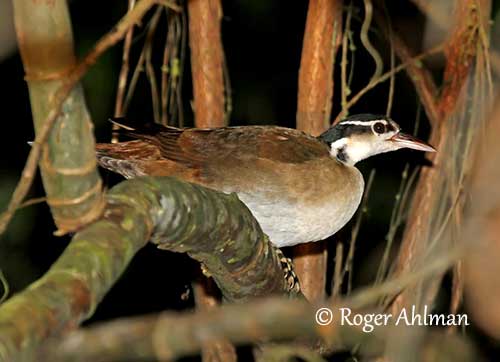
Fr : Grébifoulque d’Amérique
Ang : Sungrebe
All : Zwergbinsenralle
Esp : Avesol Americano
Ita : Svassorallo americano
Nd : Kleine Fuutkoet
Sd : amerikansk simrall
Photographers:
Roger Ahlman
Pbase Galleries Peru and Ecuador
Didier Buysse
Vision d’Oiseaux
Ken Havard
My Bird Gallery & Flickr gallery 1 & Flickr gallery 2
William Price
PBase-tereksandpiper & Flickr William Price
Text by Nicole Bouglouan
Sources:
HANDBOOK OF THE BIRDS OF THE WORLD Vol 3 by Josep del Hoyo-Andrew Elliott-Jordi Sargatal - Lynx Edicions - ISBN : 8487334202
L’ENCYCLOPEDIE MONDIALE DES OISEAUX - Dr Christopher M. Perrins - BORDAS - ISBN: 2040185607
BIRDS OF PERU by Thomas S. Schulenberg, Douglas F. Stotz, Daniel F. Lane, John P. O’Neill, Theodore A. Parker III – Princeton University Press 2007– ISBN: 978-0-691-13023-1
A GUIDE TO THE BIRDS OF MEXICO AND NORTHERN CENTRAL AMERICA by Steve N. G. Howell, Sophie Webb - Oxford University Press - ISBN: 0198540124
A GUIDE TO THE BIRDS OF COLOMBIA by Steven L. Hilty and William L. Brown - Princeton University Press – ISBN 069108372X
Neotropical Birds – Cornell Lab of Ornithology
Wikipedia, the free encyclopaedia
THE AVIANWEB - Beauty of Birds (Sibylle Faye)
CREAGUS@Monterey Bay (Don Roberson)
The Guardian - Mystery bird: Sungrebe, Heliornis fulica
Birds of Costa Rica: A Field Guide Par Carrol L. Henderson, Steve Adams
Sungrebe
Heliornis fulica
Gruiformes Order – Heliornithidae Family
INTRODUCTION:
The Sungrebe belongs to the family Heliornithidae which includes three species of three different genera: Podica (Africa), Heliopais (Asia) and Heliornis (America).
The Sungrebe is the smallest species, and occurs from SE Mexico, through Central America to N South America.
At some distance, it resembles a grebe but it is more closely related to the rails. It has lobed feet, well-adapted to a largely aquatic way of life. It can swim powerfully, run fast, clamber into trees and move around in moderate agile manner. It frequents a wide variety of habitats including both water and cover.
The Sungrebe is not gregarious. It holds a territory all year round and strongly defends this area against intruders. It feeds mainly on various aquatic insects, molluscs and crustaceans.
This species has peculiar breeding behaviour with very short incubation period of 10-11 days like small passerines. But in addition, the male is able to transport the helpless chicks in flight, in a shallow skin pocket placed under each wing.
The Sungrebe is a very special bird that deserves to be studied!

DESCRIPTION OF THE BIRD:
Biometrics:
Length: 26-33 cm
Weight: 120-153 g
The Sungrebe is a striking bird, the smallest of the family Heliornithidae.
The upperparts are olive-brown. The tail is blackish with white terminal band.
On the underparts, breast and belly are white, but flanks and lower belly are washed buff brown.
The male’s head is conspicuously patterned black-and-white. The crown is black. We can see a white stripe above the eye, like a long supercilium extending towards the hindcrown. A black, broader eyestripe extends over the ear-coverts and joins the black nape and hindneck. The cheeks are white. Chin, throat and foreneck are white, whereas the neck sides are striped vertically black and white. We can see a small, buffy-brown area on ear-coverts.
The bill has blackish upper mandible and whitish to pale pink lower mandible. The eyes are brown. The legs are yellow and blackish on tarsi, and the lobed feet are conspicuously banded black and yellow.
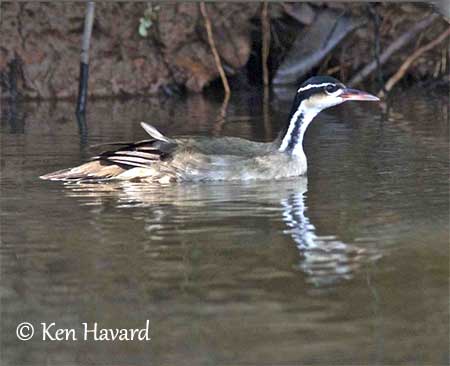
The female resembles male and is slightly smaller. She has conspicuous cinnamon patch on cheeks and upper neck sides. She has reddish eyelids and red upper mandible. Outside breeding season, she resembles male. Only the bill remains red but duller.
The juvenile is usually duller than the non-breeding adult.
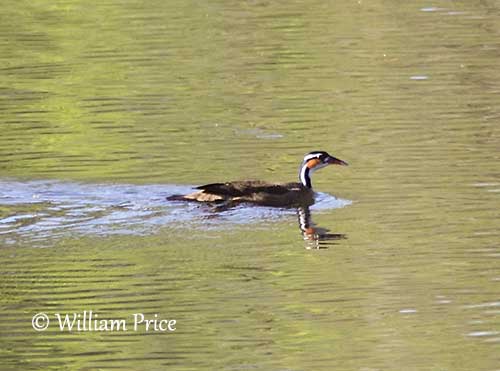
RANGE:
The Sungrebe can be found from SE Mexico, S through Central America and throughout N South America (E of the Andes), as far as Bolivia, Paraguay and NE Argentina.
HABITAT:
The Sungrebe needs water and vegetal cover. It frequents a variety of habitats such as freshwater lakes and ponds, forest streams, rivers with thick overhanging vegetation used as cover and roost. It usually favours slow-moving water. On larger bodies, it usually occurs close to the shore and the vegetation.
The species is often found below 400 metres of elevation, with only one record at 3500 metres in the Andes of Venezuela.
CALLS AND SONGS: SOUNDS BY XENO-CANTO
The Sungrebe gives distinct territorial call, rather similar to calls of some grebes “eeyooo, eeyoo, eeyoo, eeyaaa-eeyaa…”. This calls is often giver as advertising call, and before and after territorial encounters.
We can also hear series of 4-7 sharp, descending “wehk wehk wehk wehk” or a single bark “kik” and a quiet, sharp “plik”.
During the courtship displays, male and female produce soft clucking sounds also heard when they take turns at nest.
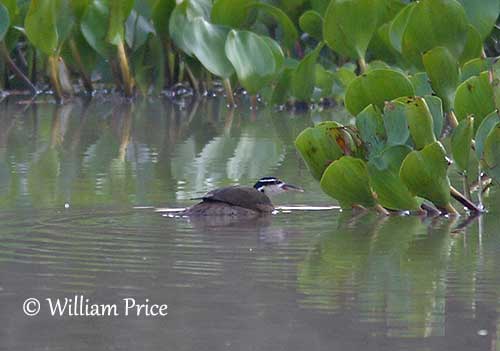
BEHAVIOUR IN THE WILD:
The Sungrebe feeds primarily on aquatic insects, adults and larvae, of several species including Hemiptera, Heteroptera, Diptera, Coleoptera and Odonata. It also consumes snails (juveniles of Pomacea dolioides, Gastropoda and Mollusca), crustaceans, small frogs, lizards and small crabs.
It feeds mainly from water surface, by swimming half-submerged and close to the shore. It swims with exaggerated back and forth movements of head and neck. It picks insects off leaves and stems of vegetation, but it can be seen jumping up off the water to catch a flying insect. It does not dive or bring up food items from below. However, the Sungrebe also feeds on land, but it is rarely observed on the shores.
The Sungrebe is a shy bird. When disturbed, it swims towards the vegetal cover or takes flight. In the middle of the day, it rests on branch above the water. At night, it roosts in higher, concealed place inside the thick vegetation. It reaches this place by climbing rather than flying.
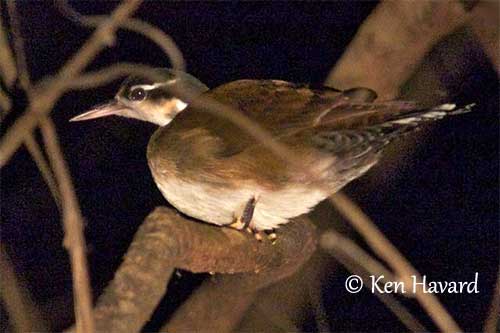
The Sungrebe breeds when the water levels are high. It is territorial all year round and defends a large area along the bank of a stream. The territorial encounters are increasing during the breeding season. The owner drives out and fights with intruders.
During the courtship displays, male and female swim in counter circles with the neck stretched out but low over the water, and the wings half-raised. Progressively, the circles decrease in size. The copulation occurs when the birds meet. The displays are accompanied by soft clucking sounds.
The Sungrebe is resident in its range. There are some records from Trinidad, one from Bonaire Island in the Caribbean, also in New Mexico, and one record from high elevation in the Andes of Venezuela.
The Sungrebe usually flies low with steady, fast wingbeats while the tail is spread. It takes off by pattering over the surface while beating the wings. It lands on water before to climb up to a resting perch.
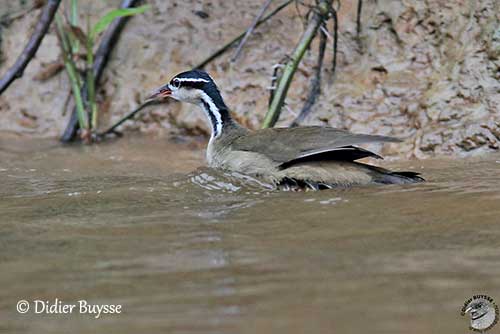
REPRODUCTION OF THIS SPECIES:
The breeding season is related to rains and high water-levels. Male and female build the nest and share the nesting duties.
They build a platform in the vegetation, overhanging the water at about 1-2 metres above the surface. The nest is made with twigs and reeds, and is sometimes lined with dead leaves. It is relatively small, 18 x 25 cm and 8 cm deep.
The female lays 2 buffy-white eggs with darker markings. Both sexes incubate during 10-11 days, a very short period fairly similar to that of small passerines.
At hatching, the chicks are highly altricial, helpless and blind, with closed eyelids. They are almost naked. The skin is pale pink with some sparse down. Bill and feet are short and poorly formed.
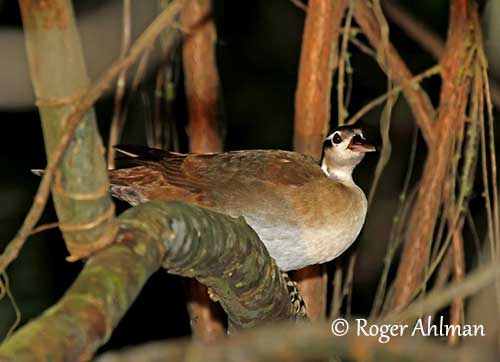
PROTECTION / THREATS / STATUS:
The Sungrebe is not globally threatened. It has a wide range but it is rarely observed. Due to human development and activities, the suitable habitats are threatened in most part of the range. In addition, the birds are sometimes caught at night in fishing nets. Drainage of wetlands for agriculture, industry or settlement expansion, deforestation, pollution and pesticides are damaging the wetlands.
The total population was estimated to number 500,000/4,999,999 individuals in 2008.
The Sungrebe is currently evaluated as Least Concern.
